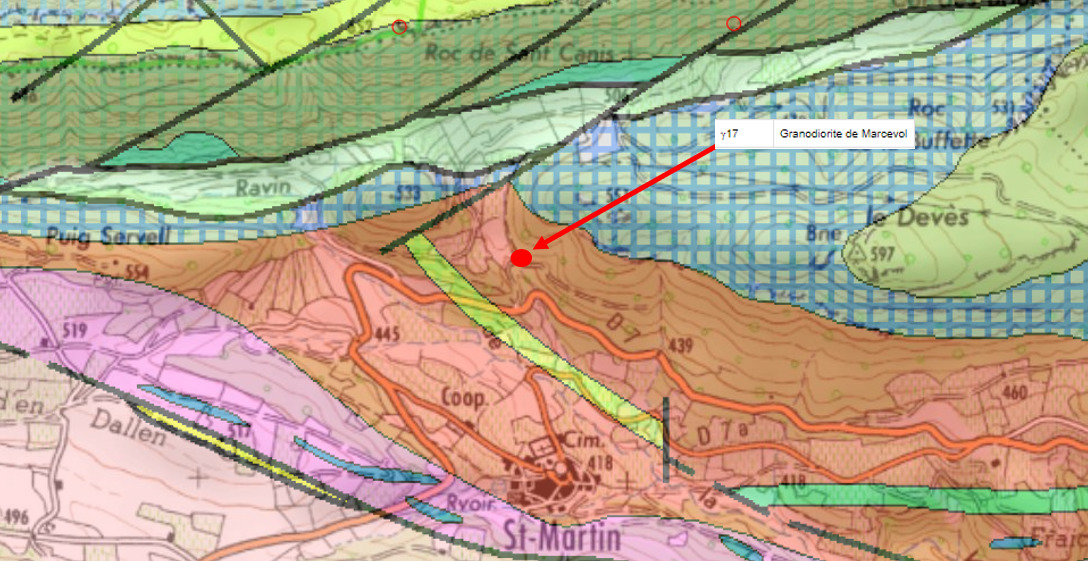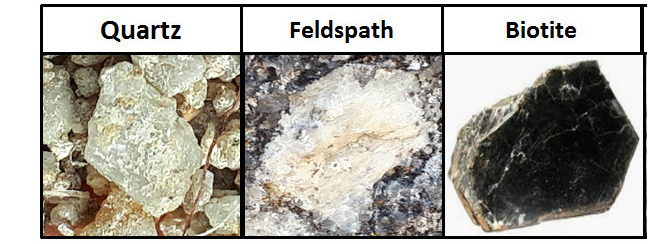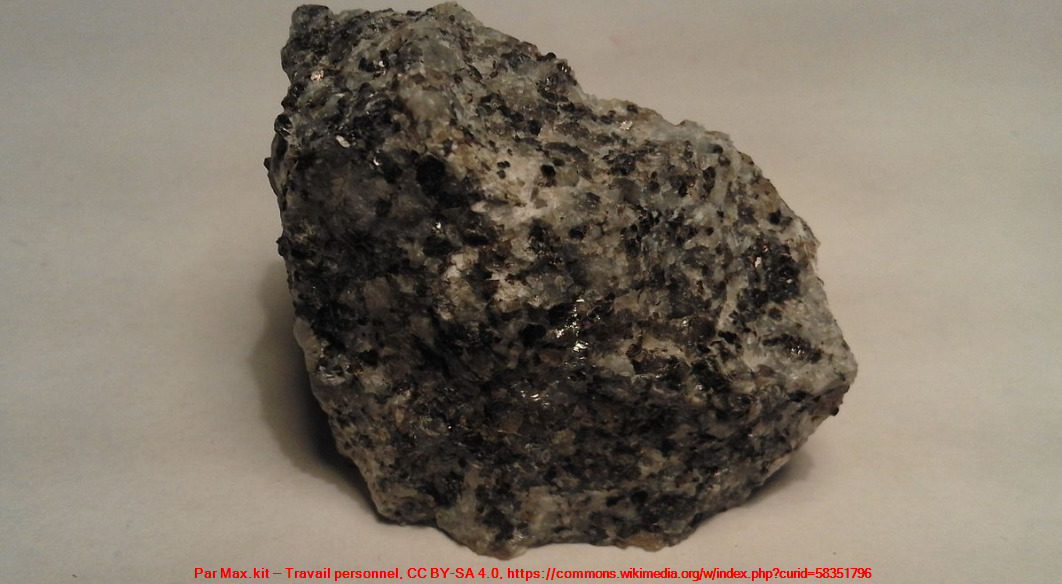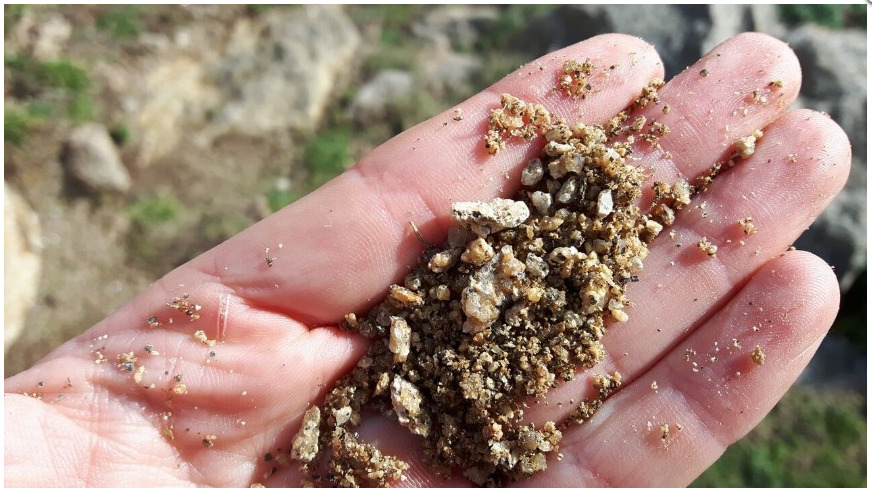
La Earthcache / The Earthcache
► Contexte géologique local
Si les crètes du synclinal du Fenouillèdes sont faites de formations calcaires du Mésozoïque, son flanc extérieur passe brutalement à une formation lithologiquement différente.

En effet, l'orogenèse pyrénéenne, en plus de former ce synclinal, a provoqué des déplacements de formations du socle hercynien, les granodiorites de Marcevol.
► Les Granodiorites de Marcevol, une roche QFM
Les Granodiorites sont des roches magmatique plutonique de texture grenue avec une composition chimique majoritaire de 3 minéraux qui peuvent se résumer en QFM :
- Q comme Quartz : translucide parfois transparent, ce minéral est de couleur gris sans facette.
- F comme Feldspath : blanchâtre ou rose, ce minéral est opaque et souvent en macles.
- M comme Mica : souvent noir (biotite), ce minéral se présente en fines paillettes brillantes.

Ces granodiorites sont nativement des roches dures et très solides.
On distingue plusieurs types de granodiorites :
- les granodiorite dérivant des granites par augmentation des feldspaths plagioclases. Dans ce cas, les minéraux noirs sont peu abondants, ce qui donne une roche claire.

- les granodiorite dérivant des diorites ou gabbros, par augmentation de la quantité de quartz. Les minéraux noirs sont présents jusqu'à hauteur de 40 %, donnant une roche sombre.

A l'air libre, ces formations plutoniques connaissent une altération particulière.
► Altération et arénisation
~ Facteurs d'altération
• l’eau : celle-ci peut être météorique ou fluviale. Elle agit par hydratation (gonflement des micas) ou hydrolyse (oxydation du fer des biotites et plagioclases).
• les végétaux : action mécanique des racines et chimiques par l'émission d'acides organiques.
Chacun des minéraux de la granodiorite réagit différemment à cette altération :
- La biotite : elle se transforme rapidement en hydroxydes de fer et argiles.
- Le feldspath plagioclase : il se transforme en argiles par hydrolyse.
- Le feldspath orthose : en phénocristal, il s’altère peu et reste présent dans l'arène.
- Le quartz : inaltérable, il fournit l'essentiel de l'arène.
~ De la roche à l'arène
Une granodiorite altérée se distingue d'abord d’une roche saine par une changement de couleur.
En effet, la mise à l'air libre entraîne l'oxydation du fer que contiennent ses minéraux, faisant passer la roche d'une couleur quasi blanche à une couleur rouille.

Les premières minéraux altérés sont les micas noirs (biotite) qui prennent une couleur rouille terne puis finissent par disparaître.
Cela entraine la fragilisation de la structure de la roche, qui prend une surface plus rugueuse et devient friable. Il est alors possible d'enlever facilement des minéraux à la roche avec la main.
L’altération se poursuivant, cette roche « pourrie » va se désagréger et se réduire à un amas de grains formant une sorte de sable grossier, l’arène granitique.
Cette arène granitique est formée de grains de quartz non altérés, de cristaux d'orthose restants, d'oxydes de fer et d'argiles.

► Local geological context
If the crests of the Fenouillèdes syncline are made of Mesozoic limestone formations, its outer flank suddenly changes to a lithologically different formation.
In fact, the Pyrenean orogeny, in addition to forming this syncline, caused displacements of formations of the Hercynian basement, the granodiorites of Marcevol.
► The Granodiorites of Marcevol, a QFM rock
Granodiorites are grainy-textured plutonic magmatic rocks with a predominant chemical composition of 3 minerals which can be summed up in QFM:
- Q for Quartz: translucent sometimes transparent, this mineral is gray without facet.
- F for Feldspar: whitish or pink, this mineral is opaque and often twinned.
- M for Mica: often black (biotite), this mineral is presented in fine shiny flakes.
These granodiorites are natively hard and very solid rocks.
There are several types of granodiorites:
- granodiorite derived from granites by increasing plagioclase feldspars. In this case, black minerals are scarce, resulting in a light rock.
- granodiorites deriving from diorites or gabbros, by increasing the quantity of quartz. Up to 40% of black minerals are present, resulting in dark rock.
In the open air, these plutonic formations experience a particular alteration.
► Alteration and arenization
~ Alteration factors
• water: this can be meteoric or fluvial. It acts by hydration (swelling of the micas) or hydrolysis (oxidation of iron from biotites and plagioclases).
• plants: mechanical action of the roots and chemicals by the emission of organic acids.
Each of the minerals in granodiorite reacts differently to this alteration:
- Biotite: it quickly transforms into iron hydroxides and clays.
- Plagioclase feldspar: it turns into clays by hydrolysis.
- Orthotic feldspar: as a phenocryst, it changes little and remains present in the arena.
- Quartz: unalterable, it provides most of the arena.
~ From rock to arena
An altered granodiorite is first distinguished from a healthy rock by a change in color.
Indeed, venting leads to the oxidation of the iron contained in its minerals, causing the rock to change from an almost white color to a rust color.
The first altered minerals are black micas (biotite) which take on a dull rusty color and then eventually disappear.
This causes the structure of the rock to weaken, which takes on a rougher surface and becomes friable. It is then possible to easily remove minerals from the rock with the hand.
As weathering continues, this "rotten" rock will disintegrate and reduce to a mass of grains forming a kind of coarse sand, the granite arena.
This granite arena is formed by unaltered quartz grains, remaining orthosis crystals, iron oxides and clays.
► Sources bibliographiques / Bibliographical sources
Les Questions / The Questions
Questions pour valider :"Granodiorites et Arénites à Saint-Martin"
Questions to validate: "Granodiorites and Arenites in Saint-Martin"
- Question 0 : Prenez une photo de vous ou d'un élément vous appartenant avec la vue depuis le PZ (sans montrer la zone d'observation).
Cette photo devra au choix nous être transmise avec les réponses ou être ajoutée à votre log.
-Question 0 : Take a photo of yourself or something you own with the view from the PZ (without showing the viewing area).
This photo must either be sent to us with the answers or added to your log.
Au WP, vous pouvez voir un affleurement de roche à droite du chemin en montant (photo WP1).
At WP, you can see a rock outcrop to the right of the path on the way up (photo WP1).

- Question 1 : Décrivez la roche sous la zone bleue A et déduisez-en sa nature géologique. Comment pouvez-vous qualifier sa texture en fonction de la taille de ces grains ?
- Question 1: Describe the rock under blue zone A and deduce its geological nature. How can you qualify its texture according to the size of these grains?
- Question 2 : En fonction de sa teinte (clair ou sombre), déduisez-en de quelle roche elle dérive.
- Question 2: Depending on its hue (light or dark), deduce from which rock it is derived.
- Question 3 : Etudiez la dureté et la cohérence de cette roche. Est-elle saine ou altérée ? Justifiez votre réponse.
- Question 3: Study the hardness and consistency of this rock. Is it healthy or damaged? Justify your answer.
- Question 4 : Quelle est la couleur de la roche sous la zone verte B. A quoi est-elle due ?
- Question 4: What is the color of the rock under the green zone B. What is it due to?
- Question 5 : Que voyez-vous sous la zone jaune C ? Quel est le principal minéral visible ? Est-ce cohérent avec la sensibilité des minéraux à l'altération ?
- Question 5: What do you see under the yellow area C? What is the main visible mineral? Is this consistent with the sensitivity of minerals to weathering?
Vous pouvez vous loguer sans attendre notre confirmation,
mais vous devez nous envoyer les réponses en même temps soit par mail via notre profil (
fafahakkai), soit via la messagerie geocaching.com (Message Center).
S'il y a des problèmes avec vos réponses nous vous en ferons part.
Les logs enregistrés sans réponse seront supprimés.
You can log this cache without waiting for our confirmation, but you must send us the answers at the same time, by e-mail via our profile (fafahakkai) or by the system of Message Center of geocaching.com.
If there is a problem with your answers we will notify you. The logs recorded without answers will be deleted.
Rappel concernant les « Earthcaches »: Il n'y a pas de conteneur à rechercher ni de logbook à renseigner. Il suffit de se rendre sur les lieux, de répondre aux questions ci-dessus et de nous renvoyer les réponses.
Reminder concerning "Earthcaches": there is neither a container to look for nor a logbook to sign. One need only go to the location, answer to the differents questions and send us the answers.